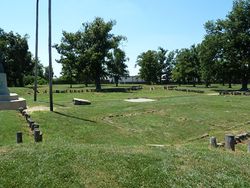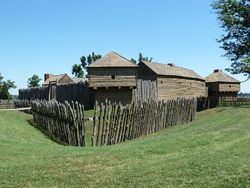Fort Massac: Difference between revisions
John Stanton (talk | contribs) |
John Stanton (talk | contribs) No edit summary |
||
| (10 intermediate revisions by 2 users not shown) | |||
| Line 1: | Line 1: | ||
{{SocialNetworks}} | {{SocialNetworks}} | ||
'''{{PAGENAME}}''' (1757-1764, 1794-1817, 1850-1864) - First established by the French in 1757 as [[Fort Ascension]]. Renamed [[Fort Massiac]] in 1759 after the French minister of marine, the Marquis de Massac. Renamed again by the Americans in 1794 as Fort Massac. Finally abandoned in 1864. | {{PageHeader}} | ||
'''{{PAGENAME}}''' (1757-1764, 1794-1817, 1850-1864) - First established by the French in 1757 as [[Fort Ascension]]. Renamed [[Fort Massiac]] in 1759 after the French minister of marine, the [[Marquis de Massac]]. Renamed again by the Americans in 1794 as Fort Massac. Finally abandoned in 1864. | |||
{|width="795px" cellpadding="5px" | {|width="795px" cellpadding="5px" | ||
|- valign="top" | |- valign="top" | ||
|width="50%"|[[Image:Fort Massac Officers Qtrs.jpg| | |width="50%"|[[Image:Fort Massac Officers Qtrs.jpg|350px|thumb|left|Fort Massac Officer's Quarters Replica]] | ||
|width="50%"|[[Image:Fort Massac West Barracks.jpg| | |width="50%"|[[Image:Fort Massac West Barracks.jpg|350px|thumb|right|Fort Massac West Barracks Replica]] | ||
|- | |- | ||
|colspan="2"|[[Image:Fort Massac River Side.jpg|795px|thumb|center|Fort Massac Replica River Side View]] | |colspan="2"|[[Image:Fort Massac River Side.jpg|795px|thumb|center|Fort Massac Replica River Side View]] | ||
|} | |} | ||
== French Fort History == | == French Fort History == | ||
[[Image:Fort Massac Original Location - 2.jpg|thumb|left|250px|Original Fort Location Marked with Posts]] | |||
[[Fort Ascension]] was completed 2 Jun 1757 by the French to protect their interests on the upper Ohio River. The fort quickly deteriorated and had to be rebuilt in 1759-60. At the end of the [[French & Indian War]] it was abandoned by the French and destroyed by Indians. The British chose not to occupy the ruined fort even though the 1763 Treaty of Paris gave them control of the territory. | [[Fort Ascension]] was completed 2 Jun 1757 by the French to protect their interests on the upper Ohio River. The fort quickly deteriorated and had to be rebuilt in 1759-60. At the end of the [[French & Indian War]] it was abandoned by the French and destroyed by Indians. The British chose not to occupy the ruined fort even though the 1763 Treaty of Paris gave them control of the territory. | ||
{{Clr}} | |||
== American Fort History== | == American Fort History== | ||
[[Image:Fort Massac Northwest Corner - 1.jpg|thumb|left| | [[Image:Fort Massac Northwest Corner - 1.jpg|thumb|left|250px|Fort Massac Northwest Corner]] | ||
In 1794 the fort was rebuilt over the ruins of the original French fort by American General [[Anthony Wayne]]. American troops occupied the fort periodically through 1817 before it was abandoned. Lewis and Clark stopped at the fort in 1803 to recruit members for the Corps of Discovery and hired on [[Pierre Drouillard]], a key member of the expedition. | In 1794 the fort was rebuilt over the ruins of the original French fort by American General [[Anthony Wayne]]. American troops occupied the fort periodically through 1817 before it was abandoned. Lewis and Clark stopped at the fort in 1803 to recruit members for the Corps of Discovery and hired on [[Pierre Drouillard]], a key member of the expedition. | ||
The fort was again rebuilt in 1850 as a factory-fort that produced all sorts of military supplies. Throughout the [[U.S. Civil War]] the fort was sporadically occupied by Union troops but was finally abandoned at the end of the war. | The fort was again rebuilt in 1850 as a factory-fort that produced all sorts of military supplies. Throughout the [[U.S. Civil War]] the fort was sporadically occupied by Union troops but was finally abandoned at the end of the war. | ||
{{Clr}} | {{Clr}} | ||
== Current Status == | == Current Status == | ||
[[Image:Fort Massac | [[Image:Fort Massac George Rogers Clark - 2.jpg|thumb|left| 250px|Fort Massac George Rogers Clark Statue]] | ||
Part of Massac State Park, Illinois. A replica of the 1802 American fort is located just to the northeast of the actual site close to the Ohio River. The actual site is outlined with log posts that indicate the location of fortifications and buildings. A statue of [[George Rogers Clark]] is also at the site of the original fort. | Part of Massac State Park, Illinois. A replica of the 1802 American fort is located just to the northeast of the actual site close to the Ohio River. The actual site is outlined with log posts that indicate the location of fortifications and buildings. A statue of [[George Rogers Clark]] is also at the site of the original fort. | ||
{{Clr}} | {{Clr}} | ||
| Line 25: | Line 26: | ||
{| | {| | ||
| | | | ||
<googlemap version="0.9" lat="37.142842" lon="-88.712062" zoom="18" width="500" scale="yes" overview="yes" controls="large" icons="http://www.fortwiki.com/mapicons/icon{label}.png"> | <googlemap version="0.9" lat="37.142842" lon="-88.712062" zoom="18" width="-500" height="-500" scale="yes" overview="yes" controls="large" icons="http://www.fortwiki.com/mapicons/icon{label}.png"> | ||
(F) 37.143124, -88.711874 | (F) 37.143124, -88.711874 | ||
Fort Massac<br>(1757-1764, 1794-1817, 1850-1864) | Fort Massac<br>(1757-1764, 1794-1817, 1850-1864) | ||
| Line 41: | Line 42: | ||
'''Links:''' | '''Links:''' | ||
* [https://penelope.uchicago.edu/Thayer/E/Gazetteer/Places/America/United_States/Illinois/_Texts/journals/JIllSHS/44/Fort_Massac.html Three articles on Fort Massac by Norman W. Caldwell] (Journal of the Illinois State Historical Society, 1950‑1951) | |||
* [http://www.northamericanforts.com/East/ilsouth.html#massac North American Forts - Fort Massac] | * [http://www.northamericanforts.com/East/ilsouth.html#massac North American Forts - Fort Massac] | ||
* [http://dnr.state.il.us/lands/landmgt/parks/r5/frmindex.htm IDNR - Fort Massac] | * [http://dnr.state.il.us/lands/landmgt/parks/r5/frmindex.htm IDNR - Fort Massac] | ||
{{Visited|30 Jun 2010}} | {{Visited|30 Jun 2010}} | ||
__NOTOC__ | __NOTOC__ | ||
{{PageFooter}} | |||
{{DEFAULTSORT:Massac}} | {{DEFAULTSORT:Massac}} | ||
[[Category:All]] | [[Category:All]] | ||
[[Category:Illinois All]] | [[Category:Illinois All]] | ||
[[Category:Illinois Forts]] | [[Category:Illinois Forts]] | ||
[[Category:Illinois Massac County]] | |||
[[Category:{{PAGENAME}}]] | [[Category:{{PAGENAME}}]] | ||
[[Category:Preserved]] | [[Category:Preserved]] | ||
Latest revision as of 08:49, 23 March 2021
|
Fort Massac (1757-1764, 1794-1817, 1850-1864) - First established by the French in 1757 as Fort Ascension. Renamed Fort Massiac in 1759 after the French minister of marine, the Marquis de Massac. Renamed again by the Americans in 1794 as Fort Massac. Finally abandoned in 1864.
French Fort History Fort Ascension was completed 2 Jun 1757 by the French to protect their interests on the upper Ohio River. The fort quickly deteriorated and had to be rebuilt in 1759-60. At the end of the French & Indian War it was abandoned by the French and destroyed by Indians. The British chose not to occupy the ruined fort even though the 1763 Treaty of Paris gave them control of the territory.
American Fort History In 1794 the fort was rebuilt over the ruins of the original French fort by American General Anthony Wayne. American troops occupied the fort periodically through 1817 before it was abandoned. Lewis and Clark stopped at the fort in 1803 to recruit members for the Corps of Discovery and hired on Pierre Drouillard, a key member of the expedition. The fort was again rebuilt in 1850 as a factory-fort that produced all sorts of military supplies. Throughout the U.S. Civil War the fort was sporadically occupied by Union troops but was finally abandoned at the end of the war.
Current Status Part of Massac State Park, Illinois. A replica of the 1802 American fort is located just to the northeast of the actual site close to the Ohio River. The actual site is outlined with log posts that indicate the location of fortifications and buildings. A statue of George Rogers Clark is also at the site of the original fort.
Sources:
Links:
Visited: 30 Jun 2010
| ||||||


